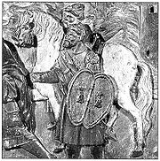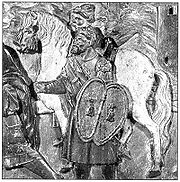
Jennet
Encyclopedia

Spain
Spain , officially the Kingdom of Spain languages]] under the European Charter for Regional or Minority Languages. In each of these, Spain's official name is as follows:;;;;;;), is a country and member state of the European Union located in southwestern Europe on the Iberian Peninsula...
horse
Horse
The horse is one of two extant subspecies of Equus ferus, or the wild horse. It is a single-hooved mammal belonging to the taxonomic family Equidae. The horse has evolved over the past 45 to 55 million years from a small multi-toed creature into the large, single-toed animal of today...
. It was noted for a smooth naturally ambling
Ambling
The term amble or ambling is used to describe a number of four-beat intermediate gaits of horses. All are faster than a walk but usually slower than a canter or gallop...
gait
Horse gait
Horse gaits are the various ways in which a horse can move, either naturally or as a result of specialized training by humans.-Classification:...
, compact and well-muscled build, and a good disposition. The jennet was an ideal light riding horse, and as such spread across Europe and provided some of the foundation bloodstock
Foundation bloodstock
Foundation bloodstock or foundation stock are horses that are the progenitor, or foundation, of a new horse breed or a given bloodline within a breed. The term is also used in a similar manner when discussing purebred dogs...
for several horse breeds in the Americas
Americas
The Americas, or America , are lands in the Western hemisphere, also known as the New World. In English, the plural form the Americas is often used to refer to the landmasses of North America and South America with their associated islands and regions, while the singular form America is primarily...
.
Spanish origin of the term
According to the 1911 Encyclopædia BritannicaEncyclopædia Britannica Eleventh Edition
The Encyclopædia Britannica Eleventh Edition is a 29-volume reference work, an edition of the Encyclopædia Britannica. It was developed during the encyclopaedia's transition from a British to an American publication. Some of its articles were written by the best-known scholars of the time...
, Jennet referred to a small Spanish horse. The 2000 edition of the American Heritage Dictionary also defines jennet, with the alternative spelling genet, as a small Spanish saddle horse. The Jennet described a type, rather than a breed of horse, and thus is not used today; the term was in regular use during the Middle Ages
Middle Ages
The Middle Ages is a periodization of European history from the 5th century to the 15th century. The Middle Ages follows the fall of the Western Roman Empire in 476 and precedes the Early Modern Era. It is the middle period of a three-period division of Western history: Classic, Medieval and Modern...
to refer to a specific type of horse
Horses in the Middle Ages
Horses in the Middle Ages differed in size, build and breed from the modern horse, and were, on average, smaller. They were also more central to society than their modern counterparts, being essential for war, agriculture, and transport....
, usually one of Iberian
Iberian horse
The Iberian horse is a title given to a number of horse breeds native to the Iberian peninsula. At present, 17 horse breeds are recognized by FAO as characteristic of the Iberian Peninsula....
or Barb
Barb (horse)
Developed on the Barbary Coast of North Africa, the Barb horse is a desert breed with great hardiness and stamina. The Barb generally possesses a fiery temperament and an atypical sport-horse conformation, but nevertheless has influenced modern breeds....
extraction, often gaited
Ambling
The term amble or ambling is used to describe a number of four-beat intermediate gaits of horses. All are faster than a walk but usually slower than a canter or gallop...
.
In the etymology
Etymology
Etymology is the study of the history of words, their origins, and how their form and meaning have changed over time.For languages with a long written history, etymologists make use of texts in these languages and texts about the languages to gather knowledge about how words were used during...
provided by the 1911 Encyclopædia Britannica, jennet is derived from the French
French language
French is a Romance language spoken as a first language in France, the Romandy region in Switzerland, Wallonia and Brussels in Belgium, Monaco, the regions of Quebec and Acadia in Canada, and by various communities elsewhere. Second-language speakers of French are distributed throughout many parts...
genet, from Spanish
Spanish language
Spanish , also known as Castilian , is a Romance language in the Ibero-Romance group that evolved from several languages and dialects in central-northern Iberia around the 9th century and gradually spread with the expansion of the Kingdom of Castile into central and southern Iberia during the...
jinete, a light horseman who rides à la jineta, explained as "with his legs tucked up." The term is taken to be a corruption of Zenata
Zenata
Zenata were an ethnic group of North Africa, who were technically an Eastern Berber group and who are found in Tunisia, Algeria and Morocco....
, a Berber
Berber people
Berbers are the indigenous peoples of North Africa west of the Nile Valley. They are continuously distributed from the Atlantic to the Siwa oasis, in Egypt, and from the Mediterranean to the Niger River. Historically they spoke the Berber language or varieties of it, which together form a branch...
tribe famed for its cavalry
Cavalry
Cavalry or horsemen were soldiers or warriors who fought mounted on horseback. Cavalry were historically the third oldest and the most mobile of the combat arms...
. English and French transferred the word from the rider to the horse, a meaning which the word has only acquired in Spain in modern times. The American Heritage Dictionary's etymology is similar, citing the Middle English
Middle English
Middle English is the stage in the history of the English language during the High and Late Middle Ages, or roughly during the four centuries between the late 11th and the late 15th century....
genet, from Old French, from the Catalan
Catalan language
Catalan is a Romance language, the national and only official language of Andorra and a co-official language in the Spanish autonomous communities of Catalonia, the Balearic Islands and Valencian Community, where it is known as Valencian , as well as in the city of Alghero, on the Italian island...
ginet, of Arabic
Arabic language
Arabic is a name applied to the descendants of the Classical Arabic language of the 6th century AD, used most prominently in the Quran, the Islamic Holy Book...
and, ultimately, of Berber
Berber languages
The Berber languages are a family of languages indigenous to North Africa, spoken from Siwa Oasis in Egypt to Morocco , and south to the countries of the Sahara Desert...
origin.http://dictionary.reference.com/search?q=jennet
Jennet is also an old-English girl's name, derived originally from John. Jennet Device was the name of the younger daughter of Elizabeth Device, one of the Pendle witches
Pendle witch trials
The trials of the Pendle witches in 1612 are among the most famous witch trials in English history, and some of the best recorded of the 17th century. The twelve accused lived in the area around Pendle Hill in Lancashire, and were charged with the murders of ten people by the use of witchcraft...
.
In Ireland, the word jennet is used for a hinny
Hinny
A hinny is a domestic equine hybrid that is the offspring of a male horse and a female donkey . It is similar to the more common mule, which is the product of a female horse and a male donkey....
.
Modern descendants and recreated breeds
The modern Spanish Jennet HorseSpanish Jennet Horse
The Spanish Jennet Horse is a new breed registry dedicated to an attempt to recreate a colored variety of gaited horse that resembles the historical Jennet or "Spanish Jennet." The Jennet was a smooth-gaited type of horse popular in the Middle Ages, known for their presence, style and smooth...
, Paso Fino
Paso Fino
The Paso Fino is a naturally gaited light horse breed dating back to horses imported to the Caribbean from Spain. Pasos are prized for their smooth, natural, four beat, lateral ambling gait and are used in many disciplines, but are especially popular for trail riding...
and Peruvian Paso
Peruvian Paso
The Peruvian Paso or Peruvian Horse is a breed of light pleasure saddle horse known for its smooth ride. It is distinguished by a natural, four-beat, lateral gait called the paso llano.-History:...
breeds probably most closely resemble the original jennet.
See also
- Horses in the Middle AgesHorses in the Middle AgesHorses in the Middle Ages differed in size, build and breed from the modern horse, and were, on average, smaller. They were also more central to society than their modern counterparts, being essential for war, agriculture, and transport....
- Iberian horseIberian horseThe Iberian horse is a title given to a number of horse breeds native to the Iberian peninsula. At present, 17 horse breeds are recognized by FAO as characteristic of the Iberian Peninsula....
- Paso FinoPaso FinoThe Paso Fino is a naturally gaited light horse breed dating back to horses imported to the Caribbean from Spain. Pasos are prized for their smooth, natural, four beat, lateral ambling gait and are used in many disciplines, but are especially popular for trail riding...
- Peruvian PasoPeruvian PasoThe Peruvian Paso or Peruvian Horse is a breed of light pleasure saddle horse known for its smooth ride. It is distinguished by a natural, four-beat, lateral gait called the paso llano.-History:...
- Spanish Jennet HorseSpanish Jennet HorseThe Spanish Jennet Horse is a new breed registry dedicated to an attempt to recreate a colored variety of gaited horse that resembles the historical Jennet or "Spanish Jennet." The Jennet was a smooth-gaited type of horse popular in the Middle Ages, known for their presence, style and smooth...
(modern breed)

